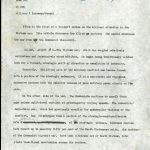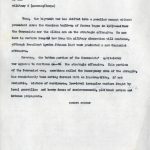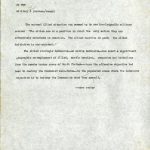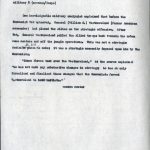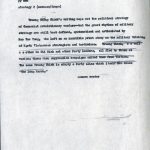1967, August 5, “Two-Part Series on Military Situation”
zczc sag Strategy.
yy nnm
military 1 (normass/deepe)
(This is the first of a two-part series on the military situation in the Vietnam war. This article discusses the Allied psposture; the second discusses the war from tir the Communist viewpoint).
SAIGON, AUGUST 6 5–The Vietnam war, which has dangled relatively motionless and indecisively since mid-June, is begin being breathlessly watched here for a violent, strategic shift of direction or escalation of intensity.
Currently, the Allied side of the military conflict has become frozen into a posture of the strategic defensive. It is a non-static and vigoriour defensive posture with the relative balance of pure military power clearly on itsthe Allied side.
On the other side of the war, the Communists continue to unroll their ownuown, unique split-level war–but at extravagantly varying speeds. The Communists’ main-force war, which had previously unveiled the spectacular violence of the conflict, has flipflopped from a posture of the strategic-counteroffensive into a movement, probably momentarystance of the strategic retreat. Informed sources here report up to possibly fifty per cent of the North vietnamese units, the backbone of the Communist big-unit war, have been withdrawn out of South Vietnam, into their traditional sanctuaries across the borders.
–more reuter
zczc sag
yy nnm
military 2 (normass/deepe)
Thus, the big-unit war has shifted into a peculiar moment without precedent since the American build-up of forces began in 1965–neither the Communists nor the Allies are on the strategic offensive. No one here is certain long is how long his military aberration will continue, although President Lyndon B. Johnson last week predicted a new Communist offensive.
However, the bottom portion of the Communists’ split-level war appears to continue on toon the strategic offensive. This portion of the Communist war, sometimes called te insurgency side of te struggle, has consistently been moving forward with an imperceptible, if not invisible, mixture of continuous, low-level irregular warfare fought by local guerrillas and heavy doses of soico-economic, and political action andAND intense propaganda.
==more reuter
zczc sag
yy nnm
military 43 (normass/deepe)
The Allied military posture took a gigantic swerve from the strategic offensive to the strategic defensive in late January this year in reaction to the Communists’ country-wide, momentary thrust into the cities. Since then, the Allied strategy has simply been a matter of shaking down and settling into this anchoring position of reaction–of waiting for the next Communist thrust. The evacuation of the Marine combat base at Khe Sanh was not this springin June was not so much a change of Allied strategy, but only a fragment of the broad sweep of this evolving strategy. shift. The Allied posture is currently frozen into this defensive pattern, which is expected here to continue at least through the American p Presidential elections in November, and perhaps even through the end of 1968.
“The orders to General (Creighton) Abrams are clear,” one informed source explained bluntly. “Don’t let the Reds pull off anything be big before the American election.”
==more reuter
zczc sag
yy nnm
military 54 (normass/deepe)
The current Allied situation was summed up by one knowledgeable military source: “The Allies are in a position in which the only action they can effectively undertake is reaction. The Allied reaction is good; the Allied initiative is non-existent.”
The Allied strategic defensive–an active defensive–has meant a significant geographic re-development of Allied, mostly American, companies and battalions from the remote border areas of South Vietnam–where the offensive objective had been to destroy the Communist main-force–to the populated areas where the defensive objective is to destroy the Communists once they assault.
–more reuter
zczc sag
yy nnm
military 65 (normass/deepe)
Currently, There are, however, two exceptions to this[the?] urban-centered troop deployments: t he first exception is along the dm demilitarized zone, where the Third Marine Division (reinforced) is based horizontally along the border with North Vietnam; the second excrp exception is a vertical deployment along the western Cambodian-Laotian fronter, where for two years the A U. S. Army 4th Infantry Division has attempted to act as an “anti-invasion” blocking force. Both of these two long-term deployments have, however, been essentially defensive–and the most static of the dfe defensive–since any forward offensive move would have meant military militarily crossing into Laos, Cambodia or North Vietnam[,. This?] which was politically prohibited by Allied policymakers, (except for small-scale clandestine operations across into these countries).
–more reuter
zczc sag
yy nnm
military 6 (normass/deepe)
The most clear-cutt evidence of this strategic sommersault is witnessed around th Saigon, where the equivalent of nearly more than eight Allied divisions are committed to the capital and the broad complex of military installations surrounding it. More than halfRoughly 40 per cent of the American combat battalions in Vietnam are committed directly or indirectly to the defense of Saigon and its periphery. Th Two-thirds of the Vietnamese strategic reserve–ten airborne and Marine battalions–are now committed inside the Saigon city limits or its suburbs. A year ago, these Allied units were sweeping the remote jungled at Communist stronghold areas at ch the near Vietnam‘s border frontiers.
The defense planof Saigon is based on troop deployments in three concentric, although irregularsomewhat circular rings. The first ring rungs from the Saigon city limits and extends roughly six miles–which is the range of Communist rockets. Roughly 2tNearly 25 per cent of the Allied troop strength defending Saigon is concentrated in this layer of territorial defense. Beyond this ruing, ranging from nine to two twelve miles outward, lies the heaviest concentration of Allied troops–five American brigades, on Aus on Ausg Australian t Tas task force, one Thai regiment, and seven reimentsregiments of Vietnamese regulars, all backed up by armor, artillery, small naval craft, helicopters and paramilitary units. This second reing contains roughly fifty per cent of thosethe Allied troops engages in defending Saigon.
==more reuter
zczc sag
yy nnm
military 7 (normass/deepe)
Beyond this, stretching towards the Cambodian border on the west and the South China Sea on the east, is committed a thinner grouping of troops–three light American brigades and two Vietnamese regiments. In these remote, thinly populated areas, where American divisions once swept through the Communist-infested bases, there is a pronounced shift to smaller unit patrols. Their objective is not to engage the Communist units as before–but simply to find the Communists and then call in Allied a irstrikes and artillery barrages on them.
Not long ago, a senior Vietnamese officer was asen astonished to see an MN American map showing the Allied troop units around Saigon. Each Allied unit wassy symbolized on the map with a thumbtack. “It will be impossil impossible to move more troops around Saigon,” he mused. “We don’t have enough room on the maps for more thumbtacks.”
==more reuter
zczc sag
yy nnm
military 8 (normass/deepe)
One knowledgeable military analysist explained that before the Communist Tet upheaval, General (William C.) Westmoreland (former American commander) had placed the Allies on the strategic offensive. After Tet, General Westmorland pulled the Allied troops back twoards the urban cene centers and off the jungle operations. This was not a strategic decision he had choseen to make; it was a strategic necessity imposed upon him by the Communists.
“Since Abrams took over the Westmorland,” ht the source explained “he has not made any substantive changes in strategy; he has oh only formalized and finalized those changes that the Communists forced Westmorland to inia initiate.”
==more reuter
zczc sag
yy nnm
military 9 (normass/deepe)
“Aside from this, what Abrams thinks and says he is doing is not being reflected ont he ground. For example, he has given the order to stop search-and-destroy operations. The field commanders are not flagrantly and deliberately disobeying this. But, in some cases, they are still conducting search-and-destroy operations, but on a smaller scale–and [they’re?] calling them different names. In other cases, the field commanders are not conducting search and destroy operations; but they are not conducting clear-and-hold operations either. They’re somewhere in between both of these.”
However, this geographic sh re d shiftingredeployment of Allied troops has produced some optismisn optimism in those military circles that formerly criticized General Westmoreland‘s over-emphasis on fighting the Communist searching for the Communist big-units along the frontiers. Specifically, Westmorland was criticized for his ratio of having to American batallions comitted committed to fighting Communist big-unit formations versus only one American battalion committed f to securing of populated areas.
“Now, interestingly and by accident, Abrams has inherited a reversal of that ratio,” the source continued. “There are now two American battalions fighting int he populated areas for versusfor every one fighting the main-force war. The Allies have now been forced to bring their troops back to the urban centers–the emphasis which Westmoreland should have had originally.”
==more reuter
zczc sag
yy nnm
military 10 (normass/deepe)
Now, General Abrams has been locked into this defensive strategy around the populated centers by the time blockade of the American elections and the threat of a future Communist offensive. Furthermore, he is being forced to de-emphasize again the big-unit offensive sweeps because of another important, but little-noticed development. These sources believe this occurred when Abrams took over command from Westmoreland.
–more reuter
zczc sag
yy nnm
military 11 (normass/deepe)
“Then, I suppose that President Johnson told Abrams he could not have any more American troops,” one military source exo explained. “At this stage, neither Johnson nor Abrams understood the implications of this. But, the ii implications in Vietnam were plain. Never before did the Americans have a strategic reserve inside Vietnam–because they never needed it. If more American troops were urgently needed, they were either in the pipeline or out-of-country ready to be shipped in. A strategic reserve should be r5 roughly 25 per cent of the communistsm deployable forces.
“Now, Abrams, if he is to have a strategic reserve, must subtract these troops from his existing deployment in Vietnam, and this must come from his American forces fighting the main-force war. Thus, Abrams is being forced to reshape the Allied strategy even more–and he is being forced to re-shape it only one way–butby de-emphasiart de-emphasizing once again the main-force war. He His other battalions in the populated areas have established the military posture suitable for pacification of the rural areas–although pacification itself is weak weakNot being effective.
“That’s where stand now.,” He concluded. This change This will be intellectually and professionally resisted by Abrams and the American military command–but it is inevitable.”
–end reuter
On the Other Hand
The Communist Perspective
The second half of Keever’s article provides insights into the Communist side of the fight.
zczc sag
yy nnm
strategy 1 (normass/deepe)
(This is the first last of a two-part series on the military situation in the Vietnam war. This article discusses the war from the Communist viewpoint).
SAIGON, AUGUST 6–A few weeks after the rampagoustumultous Communist Tet offensive, a ver veteran journalist, who had also covered the French Indo-China War, made one of his many[another periodic?] visits to Vietnam. x He shook his head aAnd lamented, “No one here has read Truong Ching Chinh. “The whole Tet offensive is spelled out in his book—by lightining attacks into the cities. But, [militar militant of North Vietnam. a leading role stion and the people’s These tactics of led “The August Communist August ofin August when?]
zczc sag
yy nnm
strategy 2 (normass/deepe)
Truong Ching Chinh‘s writing maps out the political strategy of Communist revolutionary warfare–but the great rhythms of military strategy are still best defined, systematized and articulated by Mao Tse Tung, who left on an indelible print stamp on th military thinking of North Vietnamese strategists and tacticians. Truong Chinh, a s well a s other Ho Chi Minh and Party leaders, all fled to China at various times when suppression campaigns exiled them from Vietnam. The name Truong Chinh is simply a Party alias which itself mez means “The Long March.”
==more reuter
Read Previous Article: 1967, April 26, “Open Arms Program”
Read Next Article: 1967, August 25, “Outline of Riverine Warfare”

